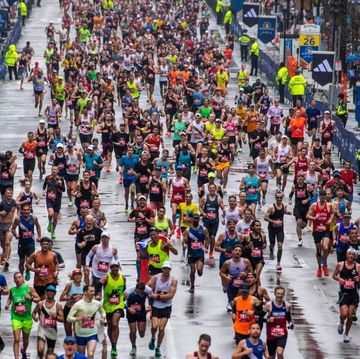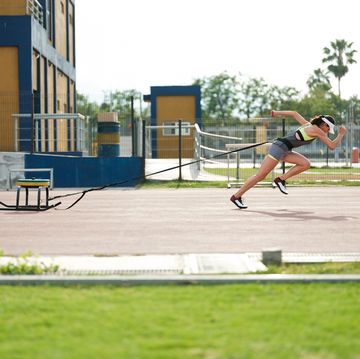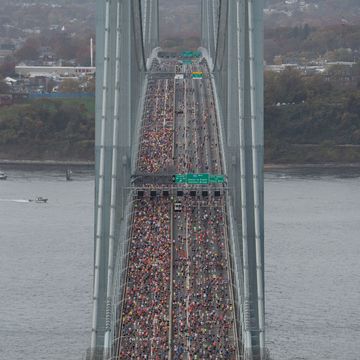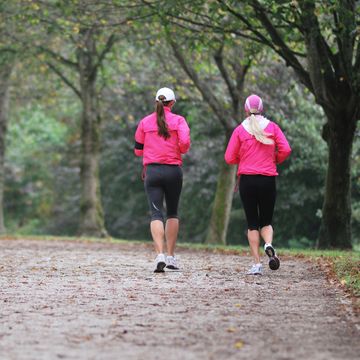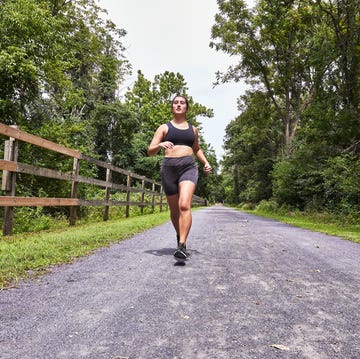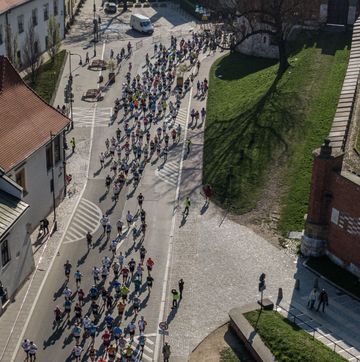After an easy 10 miles, drills, stretching, and an ice bath, Meb Keflezighi eases into a chair at a local Mammoth Lakes, Calif., diner for lunch. It's been more than an hour since he emerged from the frigid creek water where he regularly soaks after running. He's since had a hot shower, sipped hot tea while sitting in the sunny spot of his family room, and wrapped himself in a cream-colored 2012 Olympic Games fleece sweatshirt. But he embraces another warm mug, continuing his struggle to regain normal core body temperature for his 127-pound frame.
He recalls a time when he considered other choices -- he may have entertained the thought of skipping the torture of an ice bath to avoid spending the rest of an October day shivering. Now he merely wonders if the time of year has come to move the bath to the comfort of his own tub. But post-run routines aren't the only things that have had to evolve over the years.
"I remember when I first started running professionally," he says. "We'd come here after a run and I'd probably have a regular Denver omelet and hash browns. I can't do that anymore. Runners think they can eat anything, but that's not true."
Forgoing the indiscretions of his youth, bowing to a metabolism he claims has slowed, Keflezighi orders an egg-white omelet with turkey, avocado and tomato, a side of fruit and whole-wheat toast.
At 37 (turning 38 in May), he's redefining the limits of what most professional male runners can accomplish at his age, but Keflezighi's success isn't coming without his paying extraordinary attention to the details that perhaps his younger counterparts have the (temporary) luxury of ignoring. Running, it seems, is the least of what he must worry about now to remain healthy and fit enough to toe the line at what would have been his next big competition: the 2012 ING New York City Marathon, which was canceled due to the devastation wreaked by Hurricane Sandy. It would have marked his fourth 26.2-mile race in the span of one year, which included the 2011 New York City Marathon where he finished sixth, a first-place finish with a personal best of 2:09:08 at the U.S. Olympic marathon trials, and fourth place at the Olympic marathon.
Keflezighi decided against racing an alternative fall marathon, but at press time was contemplating half marathon options. He issued a statement in support of the decision to cancel New York.
"New York is my favorite place to race, so I will be back to participate in other events soon," he said. "In the meantime I would like to wish all of the people in the region the very best in recovery efforts."
While in training, most of Keflezighi's days look remarkably the same, checking off a series of to-dos from a list of carefully orchestrated tasks that individually appear unimportant, but collectively keep an athlete with a propensity for injuries running strong and in the thick of competition when it matters. At the end of the day, the majority of what he does simply comes down to aiding and speeding recovery, so he's able to bounce back each morning to train at the highest level possible. The itinerary fills almost every minute from 7 a.m. until he finally goes to bed around 10:30 p.m. -- and those sleeping hours are as vital to training as anything else.
Wake up. Stretch. Eat. Run. Drink recovery shake. Complete drills. Stretch. Ice. Eat. Return messages. Nap. Snack. Run. Go to the gym. Do core and strength training. Stretch. Eat. Massage. Compression. Stretch. Sleep. Repeat.
"I like routine," Keflezighi says. "There are no shortcuts to getting to the starting line healthy."
On a Thursday at 8:30 a.m., Keflezighi and his coach, Bob Larsen, meet at Lake Mary, an idyllic mountain spot almost 9,000 feet above sea level, where Mammoth runners typically go to complete tempo runs on a rolling 2.2-mile road loop. Following a 26-mile Sunday run and an interval workout earlier in the week, however, an easy 10 miles is on tap for the day. With red headphones in place (courtesy of one of his several sponsors), Keflezighi zigzags his way around a combination of paved and dirt trails while Larsen, with a water bottle and a discerning eye, follows on a bike.
It's exactly a month before the New York race-that-never-was and the coach is looking for subtle signs that all systems are go.
"I don't usually come out to every run, especially easy ones," Larsen says. "But I find that at this stage -- crunch time -- I can learn a lot just by observing how he looks on a recovery run, when he's not feeling fresh. Also, it's just nice for him to have fluids when he wants them."
Keflezighi's is a stride Larsen has been analyzing for 18 years now.
Larsen famously recruited Keflezighi to the University of California at Los Angeles with a full scholarship in 1994, something that wasn't typically offered to distance runners at that time. The coach visited the Keflezighi home during Meb's senior year in high school, where the work ethic and discipline that parents Russom and Awetash were instilling in their 11 children so impressed him that he decided Meb deserved the financial aid equivalent of what might otherwise recruit a few throwers or jumpers. The family had immigrated to San Diego in 1987 (by way of Milan, Italy) from war-torn Eritrea, Ethiopia. The mission of the Keflezighis was clear: They demanded that their children have an unwavering commitment to their schoolwork, in order to become productive and contributing American citizens.
Believing Larsen was granting the best chance for their child to achieve a solid education, the Keflezighi parents encouraged their third-born, who was leaving high school with a 3.95 GPA, to take it. Keflezighi and Larsen, who retired from UCLA soon after Keflezighi graduated, have been together ever since, closing in on two decades of honors that include NCAA championships, a major marathon victory in New York and an Olympic silver medal in Athens, to name just a few notable achievements.
This morning, however, is about the many smaller steps it takes to get to those monumental moments. As Keflezighi scampers down a trail to take a hard right onto the road about halfway through his run, Larsen checks out his posture, gait and foot strike, before once again chasing after him on the bike.
"Workouts -- even good ones -- aren't as telling to me as easy recovery runs," Larsen says. "You can be fast and hitting a pace [in a speed workout], but if you don't look good [on easy runs] it tells me your fitness is questionable. If your feet are still quick even in recovery and your posture is good, it says that your fitness is there and things are going well."
On this particular day, as Keflezighi finishes the run and immediately rolls into a series of plyometric drills and his rope-stretching routine, Larsen likes what he sees. And so does Keflezighi's wife, Yordanos, who completes her own run while pushing their youngest of three daughters, 2-and-a-half-year-old Yohana, in the stroller.
"Looking good," she says, giving her husband a high five and a big smile. "You're the best-looking 37-year-old out there!"
SUPPORT TEAM
It's not unusual for Keflezighi's runs to include appearances by family members. Friends say it's because of Yordanos' unyielding support that her husband has the ability to stay undeniably focused.
"She makes it possible for Meb to be the first one in the gym and the last one to leave," says Ryan Hall, fellow Olympic marathoner who at one time lived next door to the Keflezighis in Mammoth. "And when he's juggling travel, appearances, and being on the road, he does it very well. A big part of that is knowing that his family is doing well at home. Yordanos is an incredibly empowering person in his life."
Keflezighi agrees. Part of the reason he is driven to succeed is because he doesn't want to disappoint Yordanos after the sacrifices she's made -- including giving up a career in asset management -- in order for him to pursue the pinnacle of the sport.
"In the past three years, especially, she's taken on everything from paperwork to taking care of the children full-time," Keflezighi says. "Hats off to her, because it's nonstop and it's not simple. What she does is a lot of work. We are a team."
Indeed much has changed since 1998 when Keflezighi graduated from UCLA. Then, he moved back home to the San Diego area to be close to his family while living and running at the U.S. Olympic Training Center, where he also worked part-time in customer service. Not long after that, Larsen decided to retire from UCLA and join Joe Vigil, former coach at Adams State University, who was coaching Deena Kastor. They were convinced that in order to raise the level of U.S. distance running, they needed to start a training group at high altitude.
Mammoth Lakes was the location of choice and in 2001 they recruited Keflezighi and Kastor to be the charter members of what's now known as the Mammoth Track Club. Three years later, the two pioneers came home from Athens with Olympic silver and bronze in the men's and women's marathons. And although that moment was sweet, Kastor doesn't count it as Keflezighi's most notable performance.
"His fourth-place finish at the London Games was, to me, more impressive, because his training leading up to the race wasn't perfect," she says. "In Athens, his training was flawless and he was incredibly fit, but before London he was dealing with injuries and could have used a few more weeks. But he didn't panic. He focused."
In London, Keflezighi had every reason to drop out of the race -- before and during it. He missed two weeks of training with an injury to his glute, then during the race, which traversed cobblestone streets, he developed blisters so bad that he ended up in a wheelchair in the airport on the way home. He also had a crippling side stitch during the middle miles, which hampered him until mile 21, putting him in 19th place with what looked like little hope of anything better.
It was his loved ones he was most concerned about, Keflezighi says. With more than 50 family members who'd bought plane tickets, booked hotel rooms, and taken time off of work to support him, he didn't want to let anybody down. So he steadily chased down runner after runner, until he landed himself just out of the medals.
"That took guts," Keflezighi says. "I was telling myself just to enjoy the sites like Saint Paul's Cathedral. I was thinking that one day my girls will be asked if they ever got to see their Olympic-medalist dad compete. I imagined they'd say, 'Yes,' and then have to say, 'He DNFed,' and that wouldn't have sounded too good. I knew I had to get to that finish line, even though I had New York coming. It was for our country -- for pride, not appearance money or getting paid. I'm glad I finished because in retrospect I didn't know that Ryan and Abdi had dropped out. If all three of us had dropped out, it would have been a disaster."
There was very little rest for the weary afterward. Keflezighi took just enough rest to get rid of the wounds left on his blistered feet, then turned his attention to the fall racing calendar.
In early October, he's closing in on a 118-mile week, which is about where his mileage maxes out. Now standing on the side of Green Church Road on a Friday morning, about eight miles outside of town, Keflezighi gets ready for his warm-up. He'll run 3 miles easy, then stretch, do strides, a few drills, dress a blister, change into a pair of neon orange Skechers flats, and give a 12-mile tempo run his best shot with a friend pacing him on a bike and Larsen driving alongside, shouting splits and encouragement.
The tempo, he predicted the night before while at the gym completing a 45-minute strength-training regimen, probably won't be as fast as he typically targets. He'll feel the miles and the workouts he's already put in during the days leading up to it, but at this stage of the game, it's better not to push. Keflezighi is shooting for about a 5:05 pace. Larsen is, once again, more focused on his athlete's form. As the first mile ticks by, Larsen says, "He is really comfortable and running efficiently -- it's a good sign he's recovering from workouts."
Although he slips a bit off pace, clocking a couple of 5:105:12 miles, Larsen remains unconcerned and Keflezighi appears just as undaunted. His two youngest daughters scramble out of the SUV Yordanos has been driving alongside of him for the last half of the run. Fiyori, 4, is eager to share the details of the kids race she just finished at school that morning. She leaves no time for her Olympian dad to dwell on whatever feelings he had about his own workout. "We've got four weeks to go. At this point, we're still fine," Larsen says.
You'll have to excuse the coach for his lack of concern -- the pair has weathered so many ups and downs, seemingly nothing fazes them anymore. In the past 14 years, Keflezighi has bounced back from obstacles like knee injuries, infections, and a fractured hip, to losing his Nike sponsorship and mourning the loss of his good friend, Ryan Shay, who died during the 2008 Olympic marathon trials. All the personal challenges have only added to his determination to do whatever it takes to succeed.
"It really speaks volumes about his character," Hall says. "Most guys when they're hurt, they do nothing -- myself included. It's either running or not running. But Meb continues to do whatever he can. He'll fill the whole day with cross-training and physical therapy. He is very smart in his training and puts himself in exciting positions in races -- it's something I've learned from him. He always puts himself in the hunt."
Perhaps his racing tactics will be his lasting legacy. With a PR that is 6 minutes slower than the world's best, his achievements still trump those whose times he'll likely never match.
"You watch their form, their breathing, their gait, what their stride looks like -- all the stuff. No coach can tell you that. It comes natural when you practice and visualize what moves you can make. It becomes habit, almost," Keflezighi says. "But experience can also be irrelevant. In the marathon, it's a matter of who's the fittest? Who's the smartest? Who's the healthiest?"
The London Olympics will in all likelihood be Keflezighi's last. He's already committed to running the 2013 New York City Marathon and says an announcement for a spring marathon will come soon, too, but it's difficult not to wonder when he'll cross the final finish line as a professional runner. From here on out, Keflezighi says he'll assess how his body is holding up after each race and make decisions as necessary. He's started thinking about what he might do next. He's already decided in the next few months to leave the Mammoth Track Club and move back to San Diego to be closer to his parents and siblings. From there he'll likely remain in the running industry from new and different angles, perhaps through coaching. He also hopes to devote more time to the Meb Foundation, which supports health, fitness, and education organizations.
"I don't want to hold on just to hold on," Keflezighi says. "I am grateful. This sport has been great to me. I've seen the world, I've met a lot of people and some have gotten a kick out of watching me and cheering me on. It all started in seventh grade gym class when I ran a mile as fast as I could to get an A, so I didn't disappoint my parents. I didn't speak English, we didn't have money, people made fun of us, but running was the way for me to break out of my shell. I made friends."
Keflezighi says that he's accomplished "99.9 percent" of the goals he set for himself. The one remaining item on that list of to-dos?
"Win Boston," he says.
Spring is right around the corner.
STRONG TO THE CORE
Meb Keflezighi's list of career injuries is nearly as long as his list of career accolades, the most devastating probably being a fractured pelvis in 2008. Over the years he's learned to give the same attention to strength and flexibility work that he does to his running schedule. Before and after every run, Keflezighi dives into a session of plyometric drills, followed by an Active Isolated Stretching routine. He also heads to the local gym every weekday for 45 minutes of core work and more stretching --a workout he does in rapid-fire form, stopping between exercises only long enough to grab a stability or medicine ball.
"The race is the judgment, but no matter how I do, I need the peace of mind that I did everything in my power to be prepared," Keflezighi says. "That includes the little things I do every day -- the ice baths, the core work, the drills, the massages."
Typically, Keflezighi doesn't use any machines or free weights during his strength sessions, preferring exercises that use his own body weight instead. His goal is simple and not unlike that of most runners who are trying to stay healthy: maintain a strong core that supports the power and endurance he needs to perform on the run.
Here's a sampling of some of the exercises Keflezighi focuses on during his evening gym workouts. Sets include five to 10 reps of each exercise:
1. KICKING TOE TOUCHES, SIDE LEG SWINGS, STANDING KNEE RAISES: Keflezighi begins his workouts with some dynamic standing exercises that hit the hip flexors, hip extensors, adductors and abductors.
2. BICYCLES AND SCISSORS: Lying on his back with his hips elevated (his hands supporting his lower back), Keflezighi completes a series of exercises including bicycles, scissors, and touching his feet to the ground behind his head.
3. SUPERMANS: Lying face down, lifts legs off the ground, alternating right leg/left arm raised and left leg/right arm raised; rolls side to side.
4. PUSH-UPS: Completes sets of full push-ups multiple times throughout workout.
5. PLANKS: Multiple positions: On elbows facing down, on elbows or straight arms facing up (reverse planks), alternates bent knees toward chest from reverse plank position, on side with and without leg lifts.
6. CRUNCHES: Multiple styles: Regular, crossover (oblique), Russian twist holding medicine ball (sits with feet on the floor, knees bent holding ball in front, leans back 45 degrees and twists side to side from the waist).
7. PIKE SIT-UPS: Extends arms above head while lying on floor, legs straight, facing up. Lifts legs and arms simultaneously, hands reaching to touch feet. Slowly lowers arms and legs to starting position.






